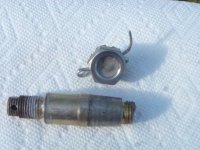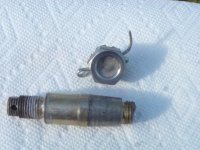I always worry about those necked down sections between the threads in the shanks. I guess in this case that wasn’t the weak link after all.
Interesting design at the other end though. What width two diameter threads involved.
What’s that all about?
I wondered about the necked down section, too.
The change in thread diameter is just an illusion of the photograph. The wrench flats and the pin hole make it look smaller, but it is all 9/16".
It's possible that I over torqued this ten years ago by looking at a table for unplated bolts and also from moving to the next slot in the nut. But I can't understand how it could survive the tightening process and then break at a later time. I know I used a torque wrench and then probably a breaker bar to get to the next slot. No impact wrench.
I used the same studs and procedure at the knuckles, so it is definitely unsettling.













